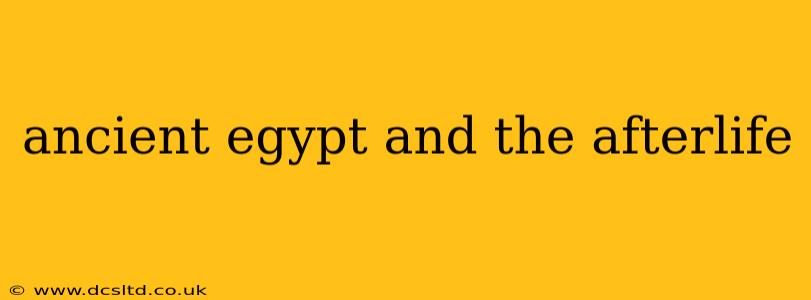Ancient Egypt, a civilization renowned for its majestic pyramids and intricate hieroglyphs, held a profound fascination with the afterlife. Death wasn't viewed as an end, but rather a transition to a continued existence, a belief deeply woven into their daily lives and reflected in their elaborate burial practices and stunning funerary art. This exploration delves into the complexities of the ancient Egyptian understanding of the afterlife, revealing a rich tapestry of beliefs, rituals, and symbolism.
What did Ancient Egyptians believe happened after death?
Ancient Egyptians believed that after death, the soul (ka) embarked on a perilous journey to the underworld, known as Duat. This journey wasn't merely a passive transition; it was an active process demanding preparation during life. Success depended on a series of trials, judgments, and rituals performed both before and after death. The ultimate goal was to achieve a form of immortality and reunification with the gods. The heart, considered the seat of the soul's essence, played a pivotal role in this judgment, weighed against the feather of Ma'at, the goddess of truth and justice. If the heart balanced the feather, the soul could proceed to the afterlife; otherwise, it was devoured by Ammit, the Devourer. This belief fundamentally shaped their worldview and their preoccupation with meticulous preparation for the afterlife.
What was the Book of the Dead?
The Book of the Dead wasn't a single book but a collection of funerary texts inscribed on papyrus scrolls, varying in content depending on the individual's status and the period. These texts served as a guide for the deceased, providing spells, prayers, and instructions to navigate the challenges of the underworld. They were not read in a linear fashion but rather utilized as a tool to aid the deceased's journey through the Duat. These spells aimed to protect the deceased, overcome obstacles, and secure a positive judgment before Osiris, the god of the underworld and judge of the dead. The elaborate illustrations within these scrolls offer fascinating glimpses into the ancient Egyptian beliefs and their visual representation of the afterlife.
How did the Ancient Egyptians prepare for the afterlife?
Preparation for the afterlife began long before death. Elaborate tombs, often filled with provisions, furniture, and personal belongings, were constructed to provide for the deceased in their continued existence. Mummification, a complex process of preserving the body, was also a crucial aspect of their preparations. This wasn't simply a matter of preserving the physical form; it was believed that the preservation of the body was essential for the soul's survival. The meticulous process of removing organs, wrapping the body in linen, and applying resins demonstrated the significance they placed on this aspect of the afterlife journey. Additionally, individuals often commissioned amulets and shabtis – small figurines believed to act as servants in the afterlife – to assist them in the Duat.
What role did gods and goddesses play in the afterlife?
Numerous gods and goddesses played critical roles in the ancient Egyptian understanding of the afterlife. Osiris, the god of the underworld, presided over the judgment of the dead. Anubis, the jackal-headed god, guided the deceased through the process of mummification and the journey to the Duat. Thoth, the god of writing and wisdom, recorded the results of the weighing of the heart ceremony. Isis, the goddess of magic and motherhood, offered protection and assistance to the deceased. The intricate interplay of these divine figures shaped the complexities and narratives of the afterlife journey.
What were the different levels of the afterlife?
While the exact nature of the afterlife's levels wasn't consistently defined across all periods of Ancient Egyptian history, various descriptions suggest differing realms within the Duat. Some texts depict a paradise-like existence in the Field of Reeds, a blissful afterlife reserved for the righteous. Others describe a more challenging journey through dangerous landscapes and trials within the Duat itself. The individual's actions in life and the success of their funerary rituals determined the specific realm they would inhabit in the afterlife. The depictions of these different levels highlight the nuanced and complex understanding of the afterlife held by the ancient Egyptians.
Conclusion:
The ancient Egyptian belief in the afterlife was a deeply ingrained aspect of their culture, shaping their worldview, social structures, and artistic expressions. From the construction of magnificent tombs to the creation of intricate funerary texts, their preparations for the afterlife reveal a civilization captivated by the mysteries of death and the promise of immortality. Their rich mythology, complex rituals, and artistic representations continue to captivate and inspire awe, offering a compelling glimpse into a civilization's profound engagement with the enduring questions of life and death.
